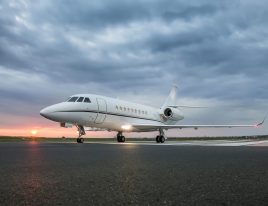Falcon 2000LX - Description
Over a decade after the release of the successful Falcon 2000, Dassault released the Falcon 2000LX. It still has all of the components that made the Falcon 2000 series great – economy, speed, a large cabin – but improved on all of these elements to make an even better jet. The long-range Falcon 2000LX, essentially the EX model with the addition of winglets, is the most advanced and up-to-date aircraft in the series.
The Falcon 2000 series is a reduced size, twin-engine version of the popular 900 line. Dassault claimed a niche in the aircraft market when it introduced the original 2000 as a wide-body jet. The 2000 aircraft boasts the same wide fuselage as the 900, but 6 ft shorter and with shorter range. Dassault received certification of the first Falcon 2000 in 1995, while the LX derivative was certified just last year. The 2000LX features modified wings and blended winglets, which allow increased climb performance and range.
The Falcon 2000LX’s biggest advantage over competitors and even predecessors is its application of winglets to the design frame. While the LX enjoys the same airfoil wing and span increase of the EX, engineers increased it even more to make room for the winglets. Designed by Aviation Partners, the winglets alone increase the LX’s range by 200 nautical miles from the EX. The 2000LX can cover 4,000 nautical miles, with eight passengers, on the same amount of fuel and thrust that it takes the EX to cover 3,800 nm. Winglets also allow the jet to climb directly to FL410 in a fleeting 18 minutes. For one minor modification, these numbers are significant.
The rest of the jet maintains the same components of the Falcon 2000 series that make it such a success. Two Pratt & Whitney Canada PW308C engines supply the power for the Falcon 2000LX. They provide 7,000 pounds of thrust apiece (1,800 more than the Falcon 2000). At sea level, the Falcon 2000EX can take off in 5,585 feet, but needs 8,120 feet of runway at an altitude of 5,000 feet and a temperature of 77°F. It has a tall certified flight ceiling of 47,000 feet. The 2000LX, like its predecessor, is able to fly at a high speed cruise of 482 knots at an altitude of 39,000 ft.
The Falcon 2000LX employs the Rockwell Collins Pro Line 4 fully-integrated avionics suite, designed for functionality and simplicity. It centers on the Honeywell EASy Avionics panel, with four 8 x 10 inch flat panel display screens. Systems are grouped by function, and displays screens are close to the functions they control. The system comes standard with an Allied Signal GNS-XES FMS (Flight Management System), a Collins TWR-850 Doppler weather radar, and a dual channel Integrated Avionics Processor System (IAPS).
As for passenger accommodations, the cabin upholds the Falcon 2000’s spacious, wide-body design. With a volume of more than 1,000 cubic feet and measurements of 6.1 ft tall, 7.7 ft wide, and 26.3 ft long, the LX’s cabin is plenty roomy and comfortable for the long-range flights it travels. The cabin can hold up to 19 passengers. In a normal configuration of eight passengers, seating is arranged with three across and an aisle, and also divided into forward and rear lounge areas. Two seats can fold down flat, to enable comfortable napping in bed-like form. True to the French dedication to style, a wide variety of interior decorating options are available – for example, there are eighteen different metal finishes to choose from just for the bathroom sink alone. A stand-up lavatory and 134 cubic feet of accessible baggage space are additional features.
A highly-successful series that constantly gets better and better is hard to come by. With the Falcon 2000 aircraft, Dassault continues to make vast improvements on what is already a superior series. This is evident in their latest Falcon 2000LX, boasting qualities that are inherent to the line, but improving on design and performance as well. The Falcon 2000’s LX version offers the same exceptional cabin space, due to its wide body, and performance that has made leaps and bounds since its initial introduction.






